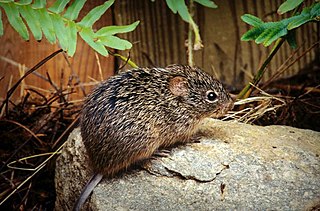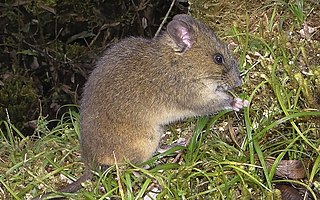
The rodent subfamily Sigmodontinae includes New World rats and mice, with at least 376 species. Many authorities include the Neotominae and Tylomyinae as part of a larger definition of Sigmodontinae. When those genera are included, the species count numbers at least 508. Their distribution includes much of the New World, but the genera are predominantly South American, such as brucies. They invaded South America from Central America as part of the Great American Interchange near the end of the Miocene, about 5 million years ago. Sigmodontines proceeded to diversify explosively in the formerly isolated continent. They inhabit many of the same ecological niches that the Murinae occupy in the Old World.
Neacomys dubosti, also known as Dubost's neacomys or Dubost's bristly mouse, is a species of South American rodent in the genus Neacomys of family Cricetidae. It is found in French Guiana, southeastern Suriname and nearby Amapá, Brazil. It was not recognized as distinct from N. guianae until 2001.
Neacomys minutus, also known as the minute neacomys, the small bristly mouse, or the minute spiny mouse, is a rodent species from South America in the genus Neacomys. It is found in Brazil.
Neacomys paracou, also known as the Paracou neacomys or Paracou bristly mouse, is a rodent species from South America in the genus Neacomys. It is found in northern Brazil, French Guiana, Guyana, Suriname and southeastern Venezuela.
Neacomys spinosus, also known as the common neacomys, common bristly mouse, or bristly mouse, is a nocturnal rodent species from South America in the genus Neacomys. It is found in Bolivia, Brazil, Colombia, Ecuador and Peru, where it often lives in transition areas between lowland forest and open regions. Its diet consists of insects, seeds and fruit.
Neacomys tenuipes, also known as the narrow-footed neacomys or narrow-footed bristly mouse, is found along the northern Andes from northwestern Venezuela through Colombia into Ecuador, in rainforest at elevations from 400 to 1750 m. Populations of small Neacomys in the lowland Amazon basin, previously assigned to this species, are now recognized as belonging to separate species.
The lesser Wilfred's mouse is a species of South American rodents of the family Cricetidae. It was first described by Wilfred H. Osgood under the name Thomasomys pictipes, then into the genus Wilfredomys, and now known as Juliomys pictipes. The lesser Wilfred's mouse is endemic to northeastern Argentina and southeastern Brazil. Its physical appearance ranges from dark brown to light orange coloration and the typical size is small to medium. This species is arboreal, spending most of its time trees and living in the local forests at altitudes from sea level to 2000 m. Currently, this species is listed as Least Concern by the IUCN, but, threats include livestock farming, ranching, and wood harvesting.
The genus Neacomys, also known as bristly mice because of their spiny fur, includes several species of rodents in the tribe Oryzomyini of family Cricetidae. It is most closely related to Oligoryzomys, Oreoryzomys, and Microryzomys. Neacomys species are mainly found in the Amazon basin, but N. pictus occurs in Panama and N. tenuipes in montane Colombia.
Nesoryzomys indefessus, also known as the Santa Cruz nesoryzomys or Indefatigable Galápagos mouse, is an extinct species of rodent from the genus Nesoryzomys of family Cricetidae from Galápagos Islands of Ecuador. It formerly lived on Santa Cruz Island, but is now extinct, probably due to the introduction of black rats. Another related rodent, N. narboroughi, is sometimes considered to be a subspecies of N. indefessus.
Aepeomys is a small genus of rodents in the family Cricetidae. The species in this genus are found in Ecuador and Venezuela.
The spotted bolo mouse or Ecuadorian akodont is a species of rodent in the family Cricetidae. It is known from Ecuador and may also occur in Colombia. Little is known of its status and range.
Microryzomys is a genus of rodent in the tribe Oryzomyini of family Cricetidae. It is closely related to Oreoryzomys, Oligoryzomys, and Neacomys. It contains two species, both restricted to the Andes: M. altissimus and M. minutus.
Neacomys pictus, also known as the painted neacomys or painted bristly mouse, is a species of rodent in the genus Neacomys of family Cricetidae. It is found only in Panama.
Oreoryzomys balneator, also known as the Peruvian rice rat or Ecuadoran oryzomys, is a species of rodent in the tribe Oryzomyini of family Cricetidae. It is found in Ecuador and northern Peru in cloud forest at elevations from 1500 to 1800 m. It is the only species in the genus Oreoryzomys, which was included in Oryzomys until 2006. The genus name Oreoryzomys is a combination of ορος the Greek word for "mountain" with the old genus name Oryzomys and refers to the mountainous habitat of O. balneator. Recent research suggests that O. balneator is not closely related to Oryzomys, but instead is probably related to Microryzomys within a clade also including Neacomys and Oligoryzomys.

Thomasomys is a genus of rodent in the family Cricetidae, named after British zoologist Oldfield Thomas. Nuclear DNA sequence analysis has indicated that it is a sister taxon to Rhagomys. It contains the following species:

Oryzomyini is a tribe of rodents in the subfamily Sigmodontinae of the family Cricetidae. It includes about 120 species in about thirty genera, distributed from the eastern United States to the southernmost parts of South America, including many offshore islands. It is part of the clade Oryzomyalia, which includes most of the South American Sigmodontinae.

Aegialomys is a genus of oryzomyine rodents from the lowlands and mountains of western Peru and Ecuador, including the Galápagos Islands. The species in this genus have historically been placed in Oryzomys, but according to cladistic research, the genus is more closely related to a group containing, among others, Nectomys and Sigmodontomys, than to Oryzomys. The generic name Aegialomys means "coastal mouse" in Ancient Greek and references the mostly coastal occurrence of the genus.

Burneo’s Oldfield mouse is a species of sigmodontine rodent in the family Cricetidae known from Sangay National Park in the eastern Andes, central Ecuador. The species is named after Ecuadorian mammalogist Santiago F. Burneo.
Neacomys aletheia, the Upper Juruá bristly mouse, is a species of rodent in the genus Neacomys.
Neacomys jau, also known as the Jaú bristly mouse, is a species of rodent in the genus Neacomys.




